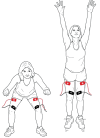Effect of patterned electrical neuromuscular stimulation on vertical jump in collegiate athletes
- PMID: 23016002
- PMCID: PMC3445136
- DOI: 10.1177/1941738110397871
Effect of patterned electrical neuromuscular stimulation on vertical jump in collegiate athletes
Abstract
Background: Patterned electrical neuromuscular stimulation (PENS) uses the electrical stimulation of sensory and motor nerves to achieve a skeletal muscle contraction using an electromyogram-derived functional pattern. PENS is used extensively for neuromuscular reeducation and treatment of muscle disuse atrophy.
Purpose: To explore the effectiveness of PENS as applied to the quadriceps muscles on the vertical jump of an athletic population.
Study design: Experimental with control and repeated measures over time.
Methods: Healthy college athletes (54 women, 75 men) were divided into 3 groups (control, n = 30; jump, n = 33; and jump with PENS, n = 63). There was no difference among groups' height and weight. Athletes performed a baseline standing vertical jump using a vertical jump system. The control group continued its normal daily activities with no jumping tasks included. The jump groups performed 3 sets of 12 repetitions with a 2-minute rest between sets at a frequency of 3 times per week. The PENS group did the jumping with the coordination of an electrical stimulation system. Vertical jump was retested after 6 weeks of intervention and 2 weeks after cessation.
Results: A 3-way repeated measures analysis of variance for time (control, jump alone, jump with PENS) revealed a significant difference (P < 0.05) for time and an interaction between time and treatment, as well as a significant difference for the PENS group from baseline to posttest and for the jump group from posttest to follow-up jump. There was no significant difference between groups for the baseline vertical jump.
Conclusions: This study demonstrated that 6 weeks of vertical jump training coordinated with PENS resulted in a greater increase than jumping only or control. This pattern of stimulation with PENS in combination with jump training may positively affect jumping.
Keywords: electrical stimulation; jumping; muscle reeducation; patterned stimulation.
Figures
Similar articles
-
Influence of patterned electrical neuromuscular stimulation on quadriceps activation in individuals with knee joint injury.Int J Sports Phys Ther. 2014 Dec;9(7):915-23. Int J Sports Phys Ther. 2014. PMID: 25540707 Free PMC article.
-
Effects of an Intervention Program on Lower Extremity Biomechanics in Stop-Jump and Side-Cutting Tasks.Am J Sports Med. 2018 Oct;46(12):3014-3022. doi: 10.1177/0363546518793393. Epub 2018 Aug 27. Am J Sports Med. 2018. PMID: 30148646
-
Effect of a neuromuscular training program on the kinetics and kinematics of jumping tasks.Am J Sports Med. 2008 Jun;36(6):1081-6. doi: 10.1177/0363546508314425. Epub 2008 Mar 21. Am J Sports Med. 2008. PMID: 18359820
-
Effects of Plyometric Jump Training on Jump and Sprint Performance in Young Male Soccer Players: A Systematic Review and Meta-analysis.Sports Med. 2020 Dec;50(12):2125-2143. doi: 10.1007/s40279-020-01337-1. Sports Med. 2020. PMID: 32915430
-
Drop jumping as a training method for jumping ability.Sports Med. 1990 Jan;9(1):7-22. doi: 10.2165/00007256-199009010-00002. Sports Med. 1990. PMID: 2408119 Review.
Cited by
-
Immediate Effect of Patterned Electrical Neuromuscular Stimulation on Pain and Muscle Activation in Individuals With Patellofemoral Pain.J Athl Train. 2016 Feb;51(2):118-28. doi: 10.4085/1062-6050-51.4.06. Epub 2016 Mar 11. J Athl Train. 2016. PMID: 26967547 Free PMC article. Clinical Trial.
-
Weak but Critical Links between Primary Somatosensory Centers and Motor Cortex during Movement.Front Hum Neurosci. 2018 Jan 17;12:1. doi: 10.3389/fnhum.2018.00001. eCollection 2018. Front Hum Neurosci. 2018. PMID: 29387003 Free PMC article.
-
Influence of patterned electrical neuromuscular stimulation on quadriceps activation in individuals with knee joint injury.Int J Sports Phys Ther. 2014 Dec;9(7):915-23. Int J Sports Phys Ther. 2014. PMID: 25540707 Free PMC article.
-
Can the Use of Neuromuscular Electrical Stimulation Be Improved to Optimize Quadriceps Strengthening?Sports Health. 2016 Jan-Feb;8(1):79-85. doi: 10.1177/1941738115618174. Sports Health. 2016. PMID: 26582349 Free PMC article. Review.
References
-
- Andrews RJ. Neuroprotection Trek: the next generation, Neuromodulation II. Applications: epilepsy, nerve regeneration, neurotrophins. Ann N Y Acad Sci. 2003;993:14-24 - PubMed
-
- Bax L, Staes F, Verhagen A. Does neuromuscular electrical stimulation strengthen the quadriceps femoris? A systematic review of randomized controlled trials. Sports Med. 2005;35(3):191-212 - PubMed
-
- Boutelle D, Smith B, Malone T. A strength study utilizing the Electro-Stim 180. J Orthop Sports Phys Ther. 1985;7(2):50-53 - PubMed
-
- Caggiano E, Emery T, Shirley S, Craik RL. Effects of electrical stimulation on voluntary contraction for strengthening the quadriceps femoris muscles in aged male population. J Orthop Sports Physical Ther. 1994;20(1):22-28 - PubMed
LinkOut - more resources
Full Text Sources
Other Literature Sources



